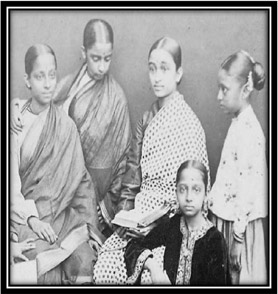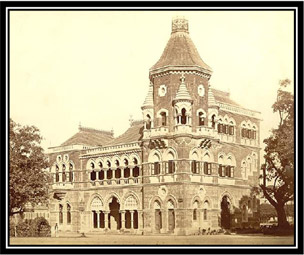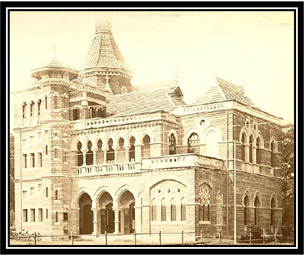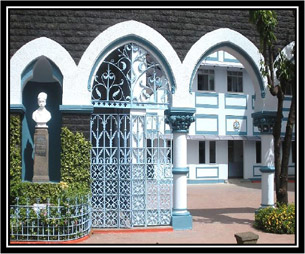A class apart
History is not just another subject at The Alexandra Girls' English Institution; the school is steeped in it. As it turns 150 years old this year, a trip down memory lane is inevitable
“I love my school.” That is the common emotion that binds together the alumni of The Alexandra Girls’ English Institution (AGEI), irrespective of the year they passed out.
Ring out the old, ring in the new: The old school building, which was demolished in the 1960s. Pic courtesy/ AGEI
The emotion is even stronger now as the school marks 150 years of existence, this year. Situated on Hazarimal Somani Marg in the Fort area, the institution was founded in 1863 by Manockjee Cursetjee. It is one of the few girls’ schools still surviving in the city. Says Alefia Kapadia former student and now a television actor, “The best memories of my life are from my school days. When I went back for the 150 years celebrations and met my teachers, they remembered many details about me, including my grades! I take pride in the fact that I can bring pride to the school.”
Its arches were preserved and stand as a reminder of the school’s rich heritage
Another person who is very proud is Freny Mehta, who has been the principal for the past 17 years. “We started our 150th year on September 1 this year," says Mehta. “We had a special function at Y B Chavan Auditorium to mark the occasion with the release of a postal cover and the launch of our school website. We held inter-school competitions on October 1 and 2 as part of our festival called Alexcellencia. Thirty-three schools following different syllabi – ICSE, CBSE, SSC – participated. We did not participate. More events are scheduled.”
The building the school functions in nowadays was built along modern lines. Pics/Sayed Sameer Abedi
Success mantra
Such competitions are encouraged as Mehta believes that they inculcate in the children a healthy measure of confidence. In fact, if there is one quality all Alexandra girls definitely have, it is confidence, she says. “Our children enter inter-school competitions – where there are IB schools and ICSE schools – and win trophies. It makes them confident. We have a special speech and drama teacher, part of the full time school staff. Every single child is trained in how to speak on stage. They may not get 99 per cent in exams but I am sure if two people are at a job interview, our child will not lag behind or fumble.”
Learning with fun: Nursery classroom with art on its walls. Pic/Sayed Sameer Abedi
The school’s most famous alumnus is Madame Bhikaji Cama, the freedom fighter who co-designed an early version of the Indian national flag and unfurled it at the International Socialist Conference in Stuttgart, Germany in 1907. Cama was a student at a time when it was unheard of for Indian girls to step out of their homes.
Proud principal: Freny Mehtau00a0
Nearly 140 years later, times have changed: India is a free country, the school’s original Gothic building has given way to a modern one and girls going to school are not an oddity. Yet, nothing seems to have changed when it comes to the impact the school has made on the students. Says Kapadia, “In Std X, I played the lead role in a play at our Annual Day celebrations. My father was most impressed with my performance and after the play ended asked me, ‘Do you want to be an actress?’ That’s when I realised that yes, acting is my passion and that’s what I want to do. It was a benchmark moment in my life.”
Talented:u00a0Alefia Kapadia
Dr Firuza Parikh, Director of Assisted Reproduction and Genetics at Jaslok Hospital and Research Centre, echoes similar sentiments. Parikh passed out in 1972 but says, “my school impacted my very being”. She recalls the day she decided to be a doctor, “I was assigned a science project on haemophilia, a blood disorder. It had a two-week deadline. I completed it in five days’ time. My science teacher Mrs Talpade displayed it for all to see. While praising the project, my class teacher Mrs Mody said that it was exceptionally good, but the handwriting fitted that of a doctor! It was as if my destiny was sealed on that day.”
Achiever:u00a0Dr Firuza Parikhu00a0
Fun curriculum
Another thing that hasn’t changed is the school’s affiliation with the state board of education. At a time when CBSE, ICSE and IB education systems are gaining ground, it isn’t difficult for the school to stick to the SSC syllabus, says Mehta. “We are an old, traditional school. We do very well with our SSC. Whether it is SSC or CBSE, knowledge is knowledge. And now SSC is also upgrading its syllabus and bringing it to the level of ICSE and CBSE. We want all students to pass with good marks, not just a few clever ones. Our focus is on developing the all- round personality of the child. We have subjects like elocution and judo within the timetable, other than the usual art, music and computers, which every school has.” Madniya Mozawala, a professional artist, who passed out of the school in 2002, is a good example of the focus on extra-curricular activities as well. She says, “I always knew I wanted to paint and my art teacher encouraged me. If it was not for her and Art being taught in school, I would have lagged behind when I joined JJ School of Art.”
Artistic:u00a0Madniya Mozawala
Changing times
AGEI has little less than 1,100 students currently, with only two divisions per standard. “It is sad that many schools have become commercialised,” says Mehta, “but our school is staying true to its old-time tradition. Our board of directors and trustees are educationists. Our aim is to give good education so that girls are able to take their place in society.”
Bravehearts: Madame Bhikaji Cama and her classmates of the batch of 1873. Pic courtesy/AGEI
That may have been founder Cursetjee’s wish at a time when girls’ education was not thought of. However, in the years since, the demographics of the city have changed. While the school has witnessed landmark historical events, it has also seen the surrounding area transform into a commercial district with very few residences left. Redevelopment is the new buzzword and the school is feeling the impact. Admits Mehta, “On this side of town, residential areas are becoming lesser. Many people are moving towards the suburbs. Here, most of the areas are going under redevelopment. Many of our kids have gone to the suburbs, because their areas are being redeveloped. They tell us, ‘When we come back after two years, please see that there is a seat for us in the school’. This is a major problem of South Mumbai.”
On boys
Despite this, there has been no pressure to convert into a co-ed school, she says. “It (being a girls’ school) was our founder’s wish and we comply with that.” Quiz her if that doesn’t make it difficult for the students to interact with members of the opposite sex once they pass out of school, and Mehta insists it does not. “Alexandra girls are confident,” she reaffirms. Moziwala too says that it didn’t matter as she had enough male cousins at home to talk to. According to Parikh, “Although we were an all-girls’ school, we interacted with boys who were scouts during jamboories. But we had a certain shyness about us that boys in college found appealing as we had not interacted with boys on a daily basis.” Adds Kapadia, “Studying in a girls’ school does cause a little distance between the sexes. When I entered co-ed college, I was also acting in (the TV show) Just Mohabbat. Boys would recognise me and approach me. I would be embarrassed, but I overcame that pretty quickly.”
Return gifts
Their experiences with boys may be varied, but AGEI alumni are united when it comes to fondly remembering their teachers. Parikh, who later studied medicine at the Yale University, says that the school “was unique in that it was truly secular, had middle class values, emphasised on the family and taught us to respect our parents. I loved the big classrooms, the flight of stairs with the banisters on which some of the daring ones rode down, blissfully unaware of the teacher waiting at the landing to catch them. I loved my teachers who were passionate about their students.” Explains Kapadia, “The teachers inculcate discipline and are very practical in their approach to education. The staff ensures that parents are aware of what their children are doing.” No wonder then that over the years, several alumni have come forward to give back to their alma mater. One ex-student gifted an elevator to the school a few years back. Another alumnus is taking the entire teaching staff on a trip to the Andamans this December. Mozawala painted the nursery classrooms a few years ago. “I was a student at Alexandra since my nursery days. Classrooms were pretty simple even then. Ms Hemal, my art teacher, and I have been in touch even after I left school. When she and Mrs Mehta (the principal) suggested we paint the nursery classrooms, I agreed. Painting the nursery was fun.”
With exams almost having come to an end, the classrooms are empty most of the day and the school is unusually quiet. Except for the school’s office, where staff are busy putting together the application forms to be distributed in the coming week for admissions to the next batch of nursery. When those selected join AGEI in its 151st year, they will become part of an institution that continues to serve the city and is part of the South Mumbai skyline. u00a0
Factfile
>> The Alexandra Girls’ English Institution, started six years after the Indian Mutiny, has seen the two world wars and the Indian freedom struggle. Phirozeshah Mehta, Mohammed Ali Jinnah and Badruddin Tyabji have been on the school’s board as trustees.
>> The school originally had superintendents who would be appointed for a period of two years. Gulestan J Bahadurjee was the first principal and was appointed in 1922. Freny Mehta is only the fourth principal in 90 years.
>> Sarojini Naidu, Sarvapalli Radhakrishnan and Dr APJ Abdul Kalam are among the several luminaries who have visited the school.
What’s in a name?
A photograph of Madame Cama and her classmates hangs prominently on Freny Mehta’s office wall. She recalls that in its early years, the school was housed in a Gothic-style building called Albert Hall. “But it was declared unsafe in the 1960s. Before it was broken down, an extension was built on modern lines. This building (the current one) was constructed in the ’60s. We preserved the arches. Manockjee Cursetjee did not want to name the school after himself. The then reigning monarch Queen Victoria’s daughter-in-law Alexandra, the Princess of Wales, was a person with beauty and other good qualities. Cursetjee thought the princess would be a role model for the girls of the school. He named the school Alexandra after taking permission from the Queen.”u00a0
 Subscribe today by clicking the link and stay updated with the latest news!" Click here!
Subscribe today by clicking the link and stay updated with the latest news!" Click here!


















